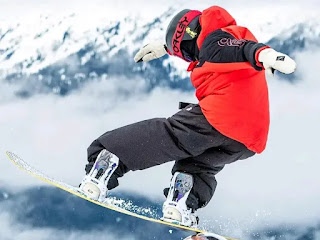Are Snowboard Bindings Supposed To Move? Check 5 Quick Fixes
Snowboard bindings should not move while you're riding. Movement in your bindings can be dangerous and indicate underlying gear problems. There are several possible causes, and it is critical to address the problem as soon as possible.
Let's go over everything you need to know about snowboard bindings... and how to prevent dangerous movements!
 |
| Are Snowboard Bindings Supposed To Move? Check 5 Quick Fixes |
What Causes Snowboard Bindings to Move?
When your snowboard bindings move while you're riding, it's annoying at best and dangerous at worst. You can imagine what might happen if they loosen to the point where they throw you off your board.
If your snowboard bindings are causing you problems, it could be due to one or more of the following factors.
- Loose screws: If your screws are not properly tightened, the bindings will not stay on the board. The bindings may become loose and cause an accident.
- Screws that are not cross-threaded: To avoid jams, the screws that hold the bindings to the snowboard should be properly cross-threaded. When the binding bolts or screws are not properly aligned with the threads of the receiving nut or hole, jams occur.
- Temperature changes: Bolts and screws shrink in cold temperatures and expand in hot temperatures. When the temperature changes while you're riding, the bindings will constantly expand and contract, causing them to move across the snowboard.
- Old hardware: vibrates a lot, just like any other piece of equipment, causing bindings to move. These vibrations, in particular, can loosen the screws and bolts, potentially throwing you off your board if left unaddressed.
- Improper sizing: If the boot and binding sizes do not match, there will be a lot of movement.
Fortunately, I'll address how to address the aforementioned issues in the following sections.
How Can You Keep Your Snowboard Bindings From Moving?
Some causes (such as vibrations and temperature fluctuations) are beyond your control, making it difficult to completely stop snowboard bindings from moving. There are, however, ways to significantly reduce the natural loosening of your bindings and keep them tight for extended periods of time.
Let's go over some of the precautions you should take. Here are the best methods for keeping snowboard bindings from moving.
1. Ascertain that the screws are not cross threaded.
Cross threading occurs when the threads of the bolt and nut do not align, causing them to cut across each other. This usually occurs when the screws are not properly inserted into the holes. Cross threading can also occur when screws are overtightened.
Examine the screws themselves as well as the screw holes in the board. If the screws you have look suspicious, try different ones.
2. Tighten the screws all the way.
If the bindings are still moving, the screws are probably not tight enough. To correct this:
- Put the bindings in their proper places.
- Get yourself a proper screwdriver. The key is to avoid using any screwdriver smaller than a number three. Otherwise, you'll have sloppy bindings or screw heads that have cammed out.
- Insert a screwdriver through the binding plate and into the tapped hole.
- Slowly turn it counterclockwise until you feel a slight bump.
- Screw it once clockwise, making a complete turn that threads the screw or nut slightly but not completely.
- Rep until all screws are securely bolted into their respective tapped holes.
- Remove all of the screws and realign the bindings if they continue to move.
3. Make use of a Thread Locker!
This stuff works like a charm. If you've done everything else and your bindings are still moving, you may need to use a thread locker to secure them to the snowboard. This method works best with damaged screws and tapped holes in snowboards.
When you purchase new bindings, you will notice that they come with screws with colored tips at the end. These tips, which are usually blue, are intended to keep them in place. They prevent bindings from moving by increasing friction between the screws and tapped holes.
After screwing and unscrewing the snowboard several times, the thread lockers eventually disappear. When this occurs, you must purchase a new thread locker bottle.
I recommend getting some Loctite (on Amazon). It works extremely well and will address the majority of movement issues.
4. Hardware should be replaced.
If you've tried everything above to fix your moving snowboard bindings and your screws still don't line up, you may have to buy new hardware. To begin, try new screws from your local hardware store. Many stores will also replace the screw holes in your snowboard if they are damaged.
Some bindings are too old or damaged to be repaired, so you should replace them. Reputable snowboard manufacturers (such as these) are now producing extremely high-quality bindings that will last for a long time without damage or wear.
5. Confirm your size and compatibility.
Check that your boot size corresponds to the binding manufacturer's recommended size range. This ensures a snug fit without requiring over-tightening to prevent movement.
How tight should I tighten my snowboard bindings?
Most snowboard bindings have two straps to keep them in place: a toe strap and an ankle strap. When you get on the snowboard, tighten both straps so your foot doesn't move around in the boot.
This may seem obvious to experienced riders, but beginners may be confused about how to tighten the bindings without cutting off circulation .
Is it normal for snowboard bindings to move?
When riding downhill, your snowboard bindings should be snug enough to prevent excessive movement. If you have to over-tighten, your boots are most likely too small for your binding size.
If you wish to check the tightness of your bindings, do the following:
- Try moving the snowboard around in a secure location. Before you go, strap in on the flat sections. Wiggle your toes. That way, if the bindings loosen again, you can re-tighten them without jeopardizing your safety.
- Request assistance from a more experienced snowboarder in tightening your bindings. They'll probably be able to tell more easily than you if your bindings are too tight (and hey: it's a great way to make a new friend!)
How to Keep Snowboard Bindings Tight.
Binding straps frequently come loose while skiing down a mountain, which can be inconvenient — especially when doing jumps and landing with heavy impacts.
As previously stated, it is impossible for snowboard bindings to not loosen at all. However, there are some things that can help keep them tighter for longer.
- In the cold, tighten your bindings. While navigating the slopes, the cold temperature causes the screws to shrink and tighten.
- Apply loctite to your screws. As previously stated, loctite can be a snowboarder's savior!
- Examine the binding flex. The flex rating of your bindings will vary depending on your skill level and riding style. Select a firmer flex rating to keep your bindings from moving.
- Purchase a portable snowboard tool. When you notice your bindings loosening, stop, check, and fix them as I described earlier.
Conclusion
It is possible that your bindings will move from time to time. However, if they move too quickly, they can cause accidents and injuries, particularly when going downhill.
Make sure your bindings are snug but not too tight. You don't want your toes to lose circulation! It also helps to have compatible hardware and optimal screws to ensure the bindings fit.
I hope this solves your problem with binding movement. If you have any questions, please leave them in the comments section below.
Enjoy your ride!





